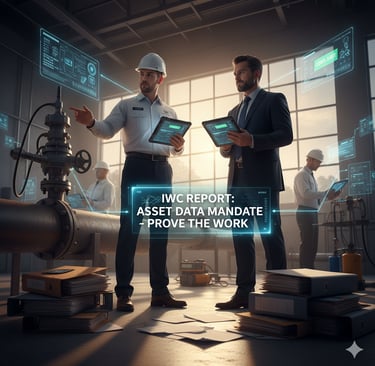The Independent Water Commission Report is a Mandate, Not a Suggestion: Why Your Asset Data is Now Your Biggest Liability
Independent Water Commission Report: Asset Health & Compliance
COMPUCAL CALIBRATION SOFTWARECALIBRATION SOTWAREMAINTENANCEVALIDATION
Bradley Hemple
11/19/20254 min read


The Independent Water Commission's Summary Report has landed, and to call it a "wake-up call" is a profound understatement. This isn't another set of guidelines to be filed away. It is a blueprint for a "fundamental reset" of the entire water sector.
For directors, operations managers, and maintenance leaders, the message is clear and unavoidable: the era of fragmented data, paper trails, and "good enough" compliance is over. The report systematically dismantles the old way of doing things and replaces it with a new, non-negotiable mandate: you must be able to prove, at a moment's notice, the health, integrity, and compliance of your entire infrastructure.
The central theme woven throughout the report’s 88 recommendations is a seismic shift from doing the work to proving the work is done correctly, on time, and with forward-looking intelligence. The question is no longer "Did we calibrate that meter?" It is now "Show me the unbreakable, time-stamped digital record for that meter's entire lifecycle, and show me the trend data that proves it's not degrading."
If that question makes you uncomfortable, you've understood the gravity of this report perfectly.
The Three Critical Gaps the IWC Report Exposes in Your Operations
While the report is comprehensive, its implications for asset management boil down to three hard-hitting realities that most water companies are not prepared to face.
1. The "Forward-Looking" Asset Health Gap (Recommendation 67)
The IWC explicitly calls for strengthening requirements for companies to "map and assess the health of their assets" and for regulators to use metrics that are "sufficiently forward-looking."
For decades, "asset health" has been a lagging indicator, measured in failures—pipe bursts, unplanned outages, compliance breaches. This is no longer acceptable. A spreadsheet of due dates and a folder of paper certificates is a historical record of what you’ve done. It provides zero forward-looking intelligence.
Regulators now require a proactive stance. They want to see the data that proves you are managing the risk of failure. For a critical pressure transmitter or flow meter, this means:
Are you tracking instrument drift over time?
Can you identify which assets require more frequent calibration based on performance data, not just a static date on a calendar?
Is your data robust enough to justify extending or shortening calibration intervals, saving significant operational costs while improving reliability?
A paper-based or manually-entered system makes answering these questions impossible. It's a black hole of data that renders you perpetually reactive.
2. The New Era of "Supervisory" Scrutiny (Recommendation 18)
The report recommends that the regulator adopt a more "supervisory approach." This is a coded term for deeper, more intrusive, and more intelligent audits. The days of showing a regulator a neat binder and ticking a box are finished.
A "supervisory approach" means the regulator will no longer just check if you did the work. They will scrutinise how you did it, how you recorded it, and who signed off on it. They will expect a "single source of truth."
Imagine an auditor on-site. They won't ask for a sample of records. They will point to a critical instrument in your network and say, "Show me everything." In a world of paper, spreadsheets, and disconnected systems, this request is a trigger for chaos. It means dispatching staff to find binders, cross-reference work orders, and manually piece together a history—a process that is slow, prone to error, and screams "disorganised" to a regulator.
3. The Inescapable Cost of Inefficiency
The report highlights an industry plagued by complexity and inefficiency, costing an estimated £250 million each Price Review cycle. While much of this is structural, a significant portion is self-inflicted through archaic internal processes.
Every hour your skilled technicians spend filling out paperwork, chasing signatures, or manually entering calibration data into a spreadsheet is an hour they are not performing value-added maintenance. Every minute a manager spends hunting for a lost certificate before an audit is a minute of high-cost, low-value stress.
This isn't just inefficient; it's a strategic drain on resources at a time when the IWC is demanding unprecedented investment in infrastructure. You are being asked to do more with less, and your manual processes are actively working against you.
Why Inaction is No Longer an Option: The Compucal Answer
This is where the conversation pivots from problem to solution. Compucal was designed for this new reality. We don't just manage calibrations; we provide the bulletproof system of record that the IWC report implicitly demands.
We directly close the gaps the report exposes:
We Deliver "Forward-Looking" Intelligence: Compucal creates a digital "golden record" for every asset. You can instantly visualise instrument drift, analyse historical performance, and make data-driven decisions on maintenance strategy. This is the very definition of a forward-looking approach.
We Make Audits Non-Events: That terrifying "show me everything" request from an auditor becomes a 30-second task. With a few clicks, you can produce the complete, time-stamped, and electronically signed history of any asset in your facility. This demonstrates a level of control and organisation that instantly satisfies regulators.
We Use Your Existing Expert Equipment: This is the critical point. A transition to a digital system does not require abandoning your multi-million-pound investment in trusted, high-end calibrators. Compucal is brand-agnostic. It works seamlessly with the Fluke, Druck, Beamex, or other equipment your team already owns and trusts. There is no expensive, disruptive hardware overhaul.
The IWC report is a watershed moment. It has fundamentally redrawn the lines of what is considered acceptable in water asset management.
Companies that cling to paper-based systems, spreadsheets, and fragmented data are not just standing still; they are actively choosing to be non-compliant with the new direction of the entire sector. The risk is no longer just inefficiency; it is regulatory intervention, public censure, and financial penalty.
The question the IWC report forces every water company to ask is no longer "What is the cost of implementing a modern, digital calibration management system?"
The question is now: "What is the undeniable and rising cost of not doing it?"
Ready to align your asset management with the new industry mandate? Contact us to schedule a strategic review of your current calibration process.
Solutions
Streamline your metrology process with our software partner CompuCal.
Support
Care
bradley@addit-metrology.co.uk
+447498 956 496
© 2025. All rights reserved.


